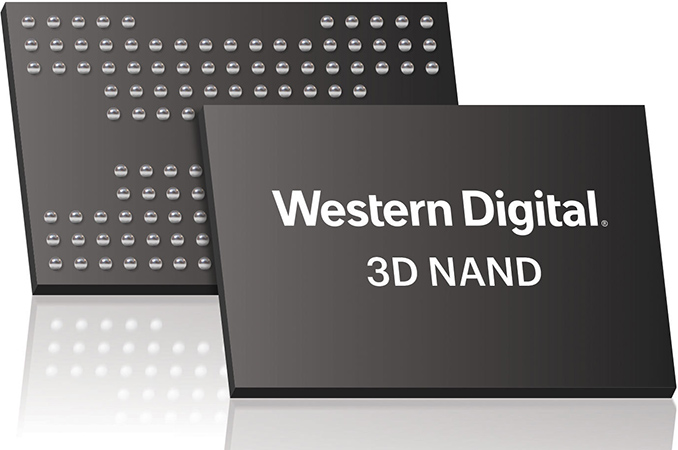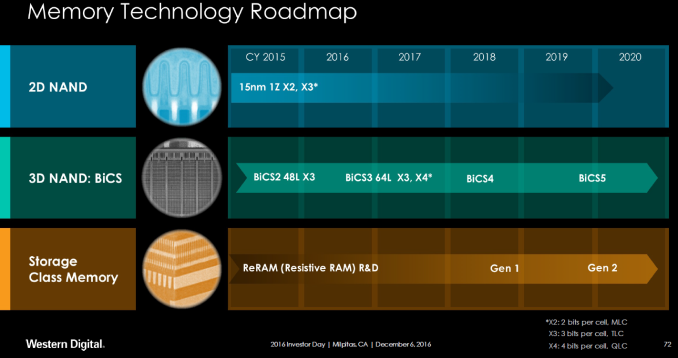Western Digital Begins to Sample QLC BiCS4: 1.33 Tbit 96-Layer 3D NAND
by Anton Shilov on July 20, 2018 2:00 PM EST
Western Digital has started sampling its 96-layer 3D NAND chips featuring QLC architecture that stores four bits per cell. The chip happens to be the world’s highest-capacity 3D NAND device. The company expects to commence volume shipments of this memory chip already this calendar year.
Western Digital’s 96-layer BICS4 3D QLC NAND chip can store up to 1.33 Tb of raw data, or around 166 GB. The IC will be initially used for consumer products Western Digital sells under the SanDisk brand, so think of memory cards (e.g., high-capacity SD and microSD products), USB drives, and some other devices. The manufacturer expects its 3D QLD NAND memory to be used in a variety of applications, including retail, mobile, embedded, client, and enterprise, but does not elaborate on timing at this point.
The 1.33-Tb BICS4 IC is Western Digital’s second-gen 3D QLC NAND device. Last year the company announced its BICS3 64-layer 3D QLC chips featuring a 768 Gb capacity, but it is unclear whether they have ever been used for commercial products. Meanwhile, it is clear that the device was used to learn about 3D QLC behavior in general (i.e., endurance, read errors, retention, etc.)
Western Digital and its manufacturing partner Toshiba started volume production of 96-layer 3D NAND earlier this year. Western Digital confirmed in late May that it had begun volume shipments of its BiCS4 memory to its retail customers, which most probably means that the new 96-layer 3D NAND ICs were used for select SanDisk-branded products. The first BiCS4 products that Western Digital announced were 256 Gb 3D TLC ICs, so it is highly likely that they have been in mass production for some time now.
As it appears, yields of 96-layer 3D NAND have been good enoug,h and things that the company has learned with BiCS3 QLC were substantial, so Western Digital moved right to its top-of-the-range capacity of 1.33 Tb per chip. What is noteworthy is that officially the BiCS4 range was to include both TLC and QLC ICs with capacities ranging from 256 Gb to 1 Tb, so the 1.33 Tb IC is a surprising addition to the lineup which signals Western Digital’s confidence of its technology.
Related Reading
- Western Digital Announce BiCS4 3D NAND: 96 Layers, TLC & QLC, Up to 1 Tb per Chip
- Western Digital: 96-Layer 3D NAND Progressing Well, Shipping to Retail Customers
- Western Digital Announces Four Bit Per Cell 64-Layer 3D NAND Flash
- Intel Teases Upcoming QLC SSD For Datacenters
- Samsung Begins Mass Production Of 96L 3D NAND
- We Found a Prototype 4 TB Intel QLC SSD
- Intel QLC NAND Updates: Up to 20TB In 2.5-inch SSD
- Intel And Micron Launch First QLC NAND: Micron 5210 ION Enterprise SATA SSD
Source: Western Digital











40 Comments
View All Comments
Reflex - Friday, July 20, 2018 - link
The reason reliability was the same for SLC vs MLC is that the drives either fail for other reasons or they reach EOL and are cycled out prior to either one failing. As a result you don't gain anything by going with more expensive/lower capacity SLC drives if both can outlast their expected service lifetime.Death666Angel - Saturday, July 21, 2018 - link
@Reflex: Was that meant as a comment to me? Because I did understand and agree with his point on the "SSDs fail before their endurance is up" point, as you just reiterated. I was and am still confused by his claim that SLC through QLC should have the same endurance, which is patently false, unless he can enlighten us with his research or show us other findings.TBW does not refer to the amount of stuff you can write to the drive before it fails (that would be along the ways of the MTBF), but to the amount of data the drive can handle (raw data, with amplification) on a cell/NAND level that the manufacturer guarantees. If you write more than the alotted amount to the NAND or the drive fails after the warranty, the manufacturer doesn't need to replace anything. If the drive fails before your warranty end or if the NAND cells go bad (read only) and you have not written more than the TBW, then you can claim warranty.
Byte - Friday, July 20, 2018 - link
My Samsung 830 128GB, is was still humming really well and still way more than fast enough. Recently did a dropin 860 EVO for space upgrade only. Barely much faster in every usage. Those 830 are golden.bill.rookard - Saturday, July 21, 2018 - link
I really like the 830's as well. VERY reliable drives. I have a lot of them floating around in my various builds in my house, and in several of my servers. Another drive which is rock solid are the older Crucial M4's and MX100 series. I have several in servers here at home and they just won't die (Good thing huh?).milkod2001 - Monday, July 23, 2018 - link
My first Samsung 830 128GB died on me within less then a year. Got replacement and it is still working for last 3 years. Can't complain just need to upgrade it due size.porcupineLTD - Saturday, July 21, 2018 - link
planar SLC aprox 60-100.000 P/E cycles3D QLC aprox 1000 P/E cycles
Did I miss some major breakthrough?
melgross - Saturday, July 21, 2018 - link
You missed the fact that, in practice, it doesn’t matter much. You’ll get a bigger drive before these die from writesporcupineLTD - Saturday, July 21, 2018 - link
You will get a new amoled phone/TV before it burns in.You will get a new iPhone before the battery cant maintain appropriate voltage.
Maybe I have a small drive or one which is written to a lot (or both) for witch 1000 P/E just doesn't cut it. Maybe I want to use the drive for a long time. Or, the craziest idea of them all maybe when I need a bigger drive I can ADD another one instead of replacing my old one (you know since the old one didn't burn through all of its P/E cycles).
This trend where you get a small price reduction for a lot lower quality is of great benefit to producing companies (Samsung already has a margin of about 75% on its memory chips) but very bad for the consumer (its already hard to find consumer MLC drives).
Oxford Guy - Saturday, July 21, 2018 - link
Is this the chant of the Planned Obsolescence Brigade?"You will be forced to get a new iPhone once your battery no longer maintains enough voltage."
"You will be forced to get a new TV before burn-in is an issue because of the use of cheap caps."
Etc.
porcupineLTD - Sunday, July 22, 2018 - link
Its not about planned obsolescence its about people defending bad/worse than already available technologies. The iPhone battery thing was a device design mistake. OLED burn in is a inherent issue of the technology (thats why Samsung despite being the best at OLED and the best at TVs makes no OLED TVs). The people here defending QLC look to me like the people that say burn in is not an issue on OLED devices or that the iPhone battery thing was not a problem since the 2 year guarantee is over so you should get a new device anyway. The technology is simply worse in almost every possible way than what we already have and the only reason we have QLC is for companies to extend their already huge margins when they could instead just expand capacity (thats why I mentioned Samsungs margin on memory chips) memory makers have huge margins but they still want to halve the production cost at the cost of durability, the fact that consumers will have to buy new drives earlier is just an added bonus.